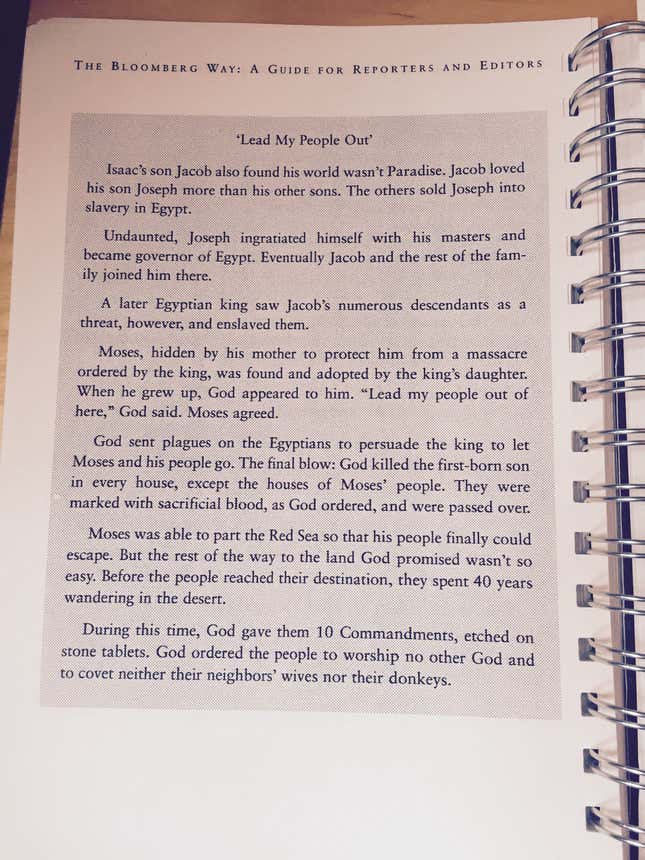The media world was stunned when it was announced last week that John Micklethwait will leave his post as editor-in-chief of The Economist to take the same spot at Bloomberg.
You couldn’t imagine a more odd mash-up of cultures than the cerebral, very British The Economist and the monolithic Bloomberg, whose news arm was built in the image of its editor-in-chief, the “deranged bowtie” Matt Winkler, who will become Pope Benedict to Micklethwait’s Pope Francis as editor-in-chief emeritus.
To compare just how different the two publishers are, Quartz took a look at both style guides—the internal bibles of all news organizations, with rules on everything from spellings to corrections. (We looked at the 10th edition of The Bloomberg Way, updated in 1998 and still being used in the mid-2000s, and the 10th edition of The Economist’s style guide, from 2010. The latest Bloomberg and Economist style guides are available for the Kindle.)
On writing:
Bloomberg’s 359-page style guide is pretty specific on who the audience is:
Bloomberg stories must be clear enough for a dope to understand and substantial enough for a professional to appreciate… Imagine your reader running out of the house in a bathrobe because he or she is intent on reading your news. You must not disappoint such a display of enthusiasm.
In order to achieve this, Bloomberg advises going back. Way back:
While few among us with attain the stature of Fitzgerald in The Great Gatsby, all of us can write with the clarity of the Old Testament.
They mean this quite seriously. The Bloomberg Way includes a 660-word summary of the “greatest story every told” complete with a Jerusalem (Bloomberg) dateline:

On the subject of good writing, The Economist uses quite a different set of examples:
In starting your article, let your model be the essays of Francis Bacon. His “Of Marriage” begins, “He that hath wife and children hath given hostages to fortune; for they are impediments to great enterprises, either of virtue or mischief.” “Of Riches” he starts with “I cannot call riches better than the baggage of virtue.”
Micklethwait will also have to get used to not being able to use contradictory ideas, as per the Bloomberg Way:
But. Avoid this. Clauses containing the word confuse more than they clarify. They force readers to deal with conflicting ideas in the same sentence, and interrupt the flow of the story. For the same reason, don’t use despite or however.
On editing:
The Economist’s approach to editing serves to praise its team of writers:
The moral for editors is that they should respect good writing. That is mainly what this style guide is designed to promote. It is not intended to impose a single style on all The Economist’s journalists. A writer’s style, after all, should reflect his mind and personality.
That’s a contrast to Bloomberg News, where major stories are often rewritten by the line editors, team leaders, managing editors, executive editor’s dogs, and more—sometimes right up to Winkler:
Editors should view EVERY story, no matter how flawed, as a challenge to make it fit to print.
In particular, the Bloomberg Way takes a dim view of slow-paced investigative journalism:
Somewhere in the 1970s, when two Washington Post reporters, Bob Woodward and Carl Bernstein, helped make ”investigative journalism” a romantic, holy endeavour, the news profession lost a great deal of sense.
Today, too many investigative journalist would miss their deadlines when confronted with a crisis and required to write FAST because their ships don’t have enough ballast, the stuff that used to put in ships so they wouldn’t capsize. Another analogy is the professional person who comes to your house to clean and says: “I don’t do beds, toilets or dishes.”
Indeed, the whole of Bloomberg has historically been based around speed. Today, it even has a Speed Desk full of reporters whose job it is to turn out bullet-pointed brilliance before other wire services. The Economist, it is fair to say, is not based around speed.
But despite working for a weekly, Micklethwait showed he was happy to inject some urgency—most recently with the launch of The Economist’s new Espresso app. But how fast is the new Bloomberg editor-in-chief prepared to go?
On Orwell:
That said, there is one thing that unites both style guides—and probably most teachers of good writing around the world. And that is a fondness of George Orwell. Both style guides refer to his work throughout their texts, specifically his six rules for writing from his 1946 essay, “Politics and the English Language.”
Those timeless rules are:
- Never use a metaphor, simile or other figure of speech which you are used to seeing in print.
- Never use a long word where a short one will do.
- If it is possible to cut a word out, always cut it out.
- Never use the passive where you can use the active.
- Never use a foreign phrase, a scientific word or a jargon word if you can think of an everyday English equivalent.
- Break any of these rules sooner than say anything outright barbarous.
